Articles
Projects update
LEE NICHOLS, Editor-in-Chief/Associate Publisher
AFRICA
Consortium to build capital-intensive waste-to-H2 project
A consortium consisting of Fertiglobe, Orascom, Scatec and the Sovereign Fund of Egypt are developing a $3-B waste-to-H2 plant in Egypt. The 1-GW plant, to be built in Port Said, will use 4 MMtpy of non-recycled plastics and agricultural waste for energy production to produce 300,000 tpy of green H2. The facility will also incorporate carbon capture technology. Green H2 deliveries are forecast to begin in late 2025/early 2026.
The consortium also plans to develop a 100-MW green H2 plant in Ain Sokhna. The electrolyzer will be supplied by Plug Power. The 100-MW electrolyzer will produce green H2 using polymer electrolyte membrane technology. The green H2 will be instrumental in enabling the facility to produce 90,000 tpy of green ammonia. The plant is scheduled to begin operations in early 2024.
ASIA-PACIFIC
Consortium to develop green H2 in Malaysia
A consortium consisting of Lotte Chemical, POSCO, Samsung Engineering and SECD Energy SDN plans to develop green H2 and ammonia production capacity in Bintulu, Sarawak, Malaysia. The H2biscus Project will convert hydropower and natural gas to green H2/methanol and blue H2. The H2 will be used to produce ammonia, which will be used domestically and exported to Korea. The plant will produce 7,000 tpy of green H2 for Sarawak’s local use; 600,000 tpy of blue ammonia; 630,000 tpy of green ammonia and 460,000 tpy of green methanol. The project is scheduled to move into pre-front-end engineering design (FEED) in 1Q, followed by FEED and the award for the engineering, procurement and construction contract.
Shanghai’s Jiading District to accelerate development of H2 fuel cells
The Jiading District of Shanghai has issued policies to promote the electrification, automation and network connection to accelerate H2 fuel cell vehicles in the area. Several companies have joined the district’s program. These companies include Horizon Robotics, Li Auto, NIO, SAIC Volkswagen, Shanghai Propulsion Technology and Volvo, among several others.
Elixir Energy progresses Gobi H2 project in Mongolia
Elixir Energy signed a Memorandum of Understanding (MoU) with Mongolia Green Finance Corp. to work together to secure financing with international financial institutions. The partnership also includes the following:
- Both parties will work to develop a large-scale forestry/nature offsets in Mongolia. These areas help offset emissions in the production stages of operations.
- Both parties will identify Mongolian carbon offset opportunities at the household level. Elixir Energy plans to reduce its exploration/appraisal stage scope 1 and 2 carbon emissions by such means.
If the project is developed, it could provide a major H2 source for customers in the region.
Tasmania to work with the Port of Rotterdam on green H2 exports
Tasmania has signed an MoU with the Port of Rotterdam to study the feasibility of green H2 exports from Bell Bay, Tasmania to the Netherlands. Tasmania’s goal is to boost green H2 production domestically for export. At the same time, the Port of Rotterdam has plans to become a major green H2 import hub in Europe. Tasmania plans to start green H2 shipments to Rotterdam by 2027.
China Yuchai launches China’s first operating H2 engine for commerical vehicles
China Yuchai announced its YCK05 H2-powered engine is operational for use in the country’s commercial vehicle market. The YCK05 H2-powered engine adopts several advanced special technologies such as high-pressure multi-point inlet air injection technology, high-efficiency low-inertia turbocharging technology, high-efficiency lean burn combustion technology, etc. The engine design upgrades the engine structure and its subsystems such as the combustion and gas distribution systems.
Reliance aims to invest heavily in H2 infrastructure
Mukesh Ambani, Chairman and Managing Director, Reliance Industries Ltd., announced plans to invest approximately $75 B in renewables infrastructure. These investments include several pathways to reach net-zero carbon emissions by 2035, including the construction of generation plants, solar panels and electrolyzers. Reliance plans to produce approximately 100 GW of renewable energy by 2030.
Japan to use H2 to reach net-zero targets by 2050
Currently, approximately 3% of the country’s energy demand is supplied by nuclear power. The island nation plans to significantly boost the use of H2 in efforts to completely wean off nuclear energy for power generation. The use of H2 will also will Japan reach net-zero targets by 2050. This includes the use of H2 in many aspects of society, including in transportation, steel making and aviation.
CANADA
Green H2 coming to Manitoba
The City of Selkirk in Manitoba is partnering with Charbone Corp. to build the city’s first green H2 production facility. Under the terms of the non-binding MoU, Charbone will develop the plant, which will provide green H2 to the city. Deliveries are expected to begin by 2023.
Enbridge Gas completes Canadian H2-blending project
Enbridge Gas has completed the more than $5-MM pilot-blending project that will enhance the existing Markham Power-to-Gas facility. The power-to-gas facility helps balance Ontario’s electricity supply and demand by storing the province’s surplus electricity as pure H2 until it is needed.
The project will also inject H2 into Enbridge Gas’ existing natural gas system. The blending of H2 and natural gas helps reduce greenhouse gas emissions, helping to decarbonize the province. Should the pilot plant be successful, it will enable Enbridge Gas to pursue larger-scale H2-blending activities in other parts of its distribution system.
Charbone and Superior join to distribute green H2 in Quebec
Charbone and Superior Propane have signed a Letter of Intent (LoI) to supply and distribute green H2 to commercial and industrial customers in Quebec. Under the LOI, Charbone will provide Superior Propane with green H2 from it H2 facility in Sorel-Tracy. H2 deliveries are scheduled to begin in 3Q of this year. Superior Propane will distribute green H2 to its customers within the mining, power generation, transportation and industrial energy sectors.
EUROPE
First commercial pink H2 deal signed in Sweden

OKG, a JV between Uniper and Fortum, has singed a commercial deal that will supply Linde with pink H2. This marks the first commercial deal for nuclear-derived H2. As part of its operations in Oskarshamn, Sweden, OKG produces H2 via electrolysis that is used as a reactor coolant—the electrolyzer can produce 12 kg/d of pink H2. However, two of the company’s reactors have been permanently closed, resulting in the excess production of H2. OKG plans to sell the excess H2 to customers, such as Linde.
H2-Fifty project to help decarbonize Rotterdam industrial operations
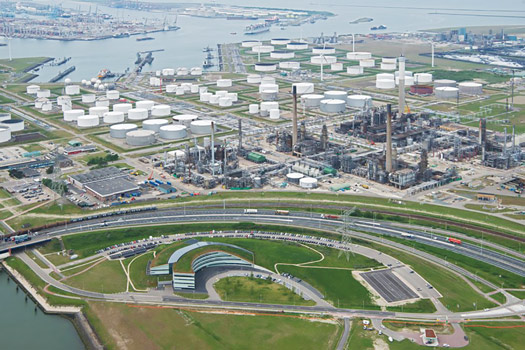
HyCC (The Hydrogen Chemistry Co.) is working with bp to develop the H2-Fifty project, a 250-MW green H2 plant at Maasvlakte in the port of Rotterdam. The facility will produce 45,000 tpy of green H2 to help decarbonize industrial operations near Rotterdam. For example, bp will use the green H2 at its Rotterdam refinery for desulfurization, replacing gray H2 made from fossil fuels that are currently used in the process.
According to HyCC, the H2-Fifty project will play an important role in the development of an H2 hub at the Port of Rotterdam. Large-scale electrolyzers will be connected to offshore wind farms at the Port of Rotterdam’s conversion park, after which the H2 will be distributed to industries throughout the port area via a central pipeline called the H2 backbone. Together, the projects will save millions of tpy of CO2.
FID on the H2-Fifty project is scheduled to be made by the end of the year. If greenlighted, operations are expected to begin in 2025.
Green Hydrogen Systems receives electrolyzer order from Logan Energy
Green Hydrogen Systems will provide two GHS HyProvide A90 electrolyzers to Logan Energy for the company’s project to develop a regional H2 economy in Dorset, England. The electrolyzers will have a combined capacity of 0.9 MW. Once operational by the end of the year, the electrolyzers will have the capacity to provide approximately 389 kg/d of green H2.
Contracts awarded for the Aldbrough storage project
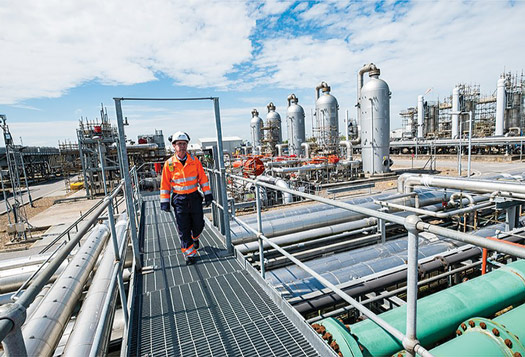
SSE Thermal and Equinor awarded contracts to Atkins and Environmental Resources Management for the Aldbrough Hydrogen Storage project. The project is a collaboration between SSE Thermal and Equinor. The JV plans to store low-carbon H2 within the area’s existing natural gas storage facility or a new H2 storage site adjacent to the Aldbrough Gas Storage facility in East Yorkshire, UK.
Atkins will conduct a feasibility study to assess the design of the H2 storage caverns, as well as the corresponding pipeline to transport H2 to and from the proposed Humber Low Carbon Pipelines being developed as part of the Zero Carbon Humber consortium. The contract includes the option for subsequent pre-FEED work.
Environmental Resources Management’s contract covers the environmental, health, safety and permitting aspects of the project.
If built, the project is scheduled to begin operations in 2028.
Centrale Nantes receives funding for GENIUS green H2 project
Centrale Nantes received funding of more than $3 MM from CPER (French state/regional infrastructure planning and investment program) for the GENIUS project. The project aims to build a full-scale test platform for the production, storage and use of green H2. The GENIUS project will combine the fuel cell/electrolyzer combination with seasonal storage in the form of H2 to supply isolated or non-isolated networks. The test will also help design power systems that combine production, storage and consumption for transport-related applications.
Yara to use electrolyzer to decarbonize ammonia production
Yara has signed a development contract with Linde Engineering for the construction of a 24-MW green H2 plant at the company’s operations in Porsgrunn, Norway. The proton exchange membrane electrolyzer—developed by ITM Power—will have a capacity of around 10,000 kg/d. The production will help Yara replace gray H2 used in the company’s ammonia production process, thereby removing 41,000 tpy of CO2 emissions. The H2 will be used to produce more than 20,000 tpy of ammonia, which can be converted to between 60,000 tpy–80,000 tpy of green fertilizer.
SHYNE project launched in Spain
In late January, Repsol announced the launch of the $3.7-B Spanish Hydrogen Network (SHYNE) project. The initiative—which strives to produce 2 GW of renewable H2 by 2030—is being developed by a consortium of 22 companies and 11 associations.
The scope of the projects includes:
- Building a renewable energy ecosystem that connects three planned industrial H2 hubs in the Basque region, Catalonia and Murcia
- The creation of two new innovation hubs in the regions of Castile-La Mancha and Madrid to develop electrolyzer technologies
- Boost green H2 capacity by 500 MW by 2025 and up to 2 GW by the end of the decade
- Increasing the use of green H2 in Spain’s transportation network. This includes the construction of 12 new H2 fueling stations by 2025
- Promoting the use of green H2 in heating and heavy industry.
According to the country’s Hydrogen Roadmap, Spain’s aim is to install 4 GW of renewable H2 by 2030. The SHYNE project will be instrumental in reaching the country’s green H2 production targets.
Phillips 66 and H2 Energy Europe to develop H2 refueling network in EU
Through a 50-50 JV between their subsidiaries, Phillips 66 and H2 Energy Europe plan to develop up to 250 retail H2 refueling stations across Austria, Denmark and Germany by 2026. The companies’ subsidiaries—Phillips 66 Ltd. and H2 Energy Europe AG—will leverage their capabilities to develop a retail network, bringing together H2 supply, refueling logistics and vehicle demand. The parties aim to supply the retail refueling network with green H2.
CIP to lead green H2 project in Northeastern Spain
A consortium consisting of Copenhagen Infrastructure Partners, Vestas, Naturgy, Enagas and Fertiberia are developing a green H2 project in Aragon, Spain. The project partners will build a 2 GW–5 GW wind and solar plant to power a 2-GW electrolyzer. The H2 produced will be piped to Valencia to be used as a raw material for fertilizer production.
Automation technologies to help accelerate PosHYdon project
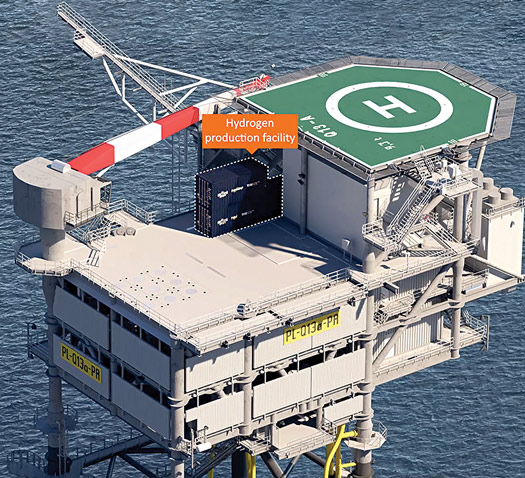
Emerson announced it is developing software to enable safe and efficient operation of the PosHYdon project, the world’s first offshore green H2 production process on an operational gas platform. According to the project’s website, the PosHYdon project will integrate three energy systems in the North Sea—offshore wind, offshore gas and offshore H2—at Neptune Energy’s Q13a-A platform. This production platform is the first fully electrified platform in the Dutch North Sea. The project will provide insight into electrolyzer efficiency from a variable power supply and the cost of installing and maintaining a green H2 production plant on an offshore platform.
Green electricity will be used to simulate the fluctuating supply from wind turbines and power the production process, which will convert sea water into demineralized water and then safely produce H2 via electrolysis. The H2 is then blended with the natural gas and transported to the coast, via the existing gas pipeline, and fed into the national gas grid. The 1 MW electrolyzer is expected to produce up to three tons of H2 per week.
Emerson’s DeltaV distributed control system, DeltaV safety instrumented system and DeltaV Live operator interface software will manage the desalination and electrolyzer units, gas blending and balance of plant equipment. By meeting the unique application challenges, including variable desalinated water feedstock and power supply, DeltaV software and systems will provide enhanced safety, process uptime and operational efficiency. The solution will ensure the existing natural gas operations remain unaffected and blended gas meets its required specification. Integration with the existing offshore systems and communication with onshore operations will maximize process visibility and prevent unforeseen issues.
PosHYdon is being developed by consortium partners Nexstep, TNO, Neptune Energy, Gasunie, Noordgastransport, NOGAT, DEME Offshore, TAQA, Eneco, Nel Hydrogen, InVesta, Hatenboer, Iv-Offshore & Energy and Emerson.
thyssenkrupp to install 200-MW green H2 facility for Shell at Port of Rotterdam
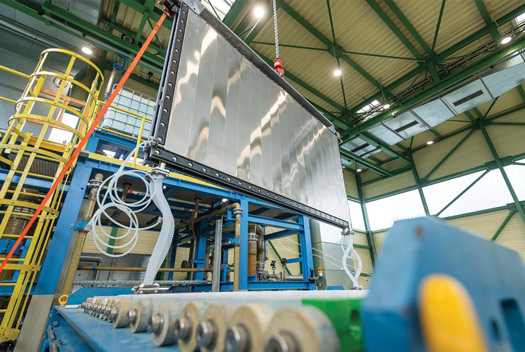
thyssenkrupp Uhde Chlorine Engineers has signed a supply contract with Shell for the large-scale project Hydrogen Holland 1 in the port of Rotterdam, Netherlands.
Under the contract, thyssenkrupp Uhde Chlorine Engineers will engineer, procure and fabricate a 200-MW electrolysis plant based on their large-scale, 20-MW alkaline water electrolysis module. First construction work for the electrolyzers will likely begin this year. Shell plans to take FID on the project in 2022. Operations are scheduled to begin in 2024.
The center of the Hydrogen Holland 1 H2 project facility will cover 2 hectares (the size of three football fields). Green H2 will be produced for industry and the transport sector, with electricity coming from the offshore wind farm Hollandse Kust Noord. The H2 can be transported through a 40-km pipeline that will run from the plant to Shell’s Energy and Chemicals Park Rotterdam. Net-zero is a priority for the plant: Reusable construction materials will be applied wherever possible and solar panels will be incorporated in the outside walls of the plant.
Consortium to develop green H2 production in Portugal
A consortium consisting of 13 companies is planning to develop a 100-MW green H2 production facility in Sines, Portugal. The project—GreenH2Atlantic—will convert a coal-fired power plant to run off H2. Construction is expected to start in 2023, with operations beginning in 2025. The project’s consortium is comprised of the following companies: EDP, Galp, ENGIE, Bondalti, Martifer, Vestas Wind Systems, McPhy and Efacec, and academic and research partners such as ISQ, INESC-TEC, DLR and CEA, as well as public-private cluster Axelera.
Netherlands creates $40-B climate and energy transition fund
The Netherlands announced plans to setup a $40-B climate and transition fund, with more than $17 B directed towards advancing renewable energy carriers. This includes the use of green H2 and e-fuels for various sectors of the country’s economy (e.g., power generation, transportation, industrial and commercial).
Snam, Sagat partner on first H2-ready fuel cell at Torino Airport
Sagat SpA and Snam have partnered to develop an H2-ready fuel cell system to provide electricity and heat to the Torino Airport in Italy. The 1.2-MW fuel cell system, designed and developed by Snam’s Hydrogen Business Unit in partnership with FuelCell Energy, is the first of its kind and size in Italy that can be fueled with variable percentages of H2 blended with natural gas for the combined generation of electricity and heat. The fuel cell will be installed at Torino Airport, the first in Italy to implement such a solution, in the second quarter of 2023.
The fuel cell system can produce up to 1.2 MWh of electricity and 840 kWh of heat per hour and can be fueled by H2 mixed with up to 40% natural gas by volume. Compared to traditional cogeneration, the use of natural gas-fueled fuel cells guarantees the substantial elimination of particulate emissions and a saving in CO2 emissions of 1,630 tpy, equivalent to 1 MM car journeys on the Turin city center-airport route. Fueling the fuel cell with H2 and biomethane further reduces greenhouse gas emissions.
LATIN AMERICA
HNH project in Chile gets a new partner

Copenhagen Infrastructure Partners plans to partner with AustriaEnergy and Oekowind on the HNH Project in Chile. The $3-B project is a large-scale, export-oriented green H2 and green ammonia project. Once operational, the HNH Project will consist of a 1.7-GW onshore wind farm, electrolyzers, ammonia plant and port facility, and is expected to produce 1 MM metric tpy of green ammonia, resulting in a substantial contribution to Chile’s ambition to be a global lead in green H2/ammonia production.
MIDDLE EAST
TotalEnergies, Masdar and Siemens to drive green H2 in the UAE
TotalEnergies, Masdar and Siemens plan to collaborate to produce green H2 and sustainable aviation fuel in the UAE. The group has already completed a range of evaluations on technology suppliers, feasibility studies and conceptual designs. FEED work is scheduled to begin this year.
bp and Oman form strategic partnership to progress H2 development
bp and the Ministry of Energy and Minerals in Oman have signed a strategic framework agreement and a renewables data collection agreement which will support the potential development of a multiple gigawatt, renewable energy and green H2 development in Oman, by 2030.
Under the agreement, bp and Oman will also consider ways to collaborate in several areas, including a renewables strategy, regulation, the establishment of a renewable energy hub, and the development and reskilling of the local workforce.
In addition, bp will capture and evaluate solar and wind data from 8,000 km2 of land. The evaluation will then support the Government of Oman in approving the future developments of renewable energy hubs at suitable locations within this area to take advantage of these resources. The renewable energy resources could also supply renewable power for the development of green H2, targeting both domestic and global export markets.
U.S.
Kansas Geological Survey to study H2 storage in underground salt beds
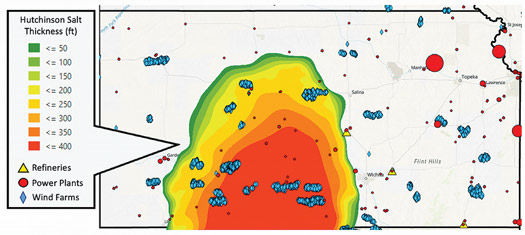
The Kansas Geological Survey and Evergy plan to study the possibility of storing excess energy generated by coal-fired power plants in underground salt caverns for future use. The excess energy can then be split into H2 and oxygen. The H2 can be stored in salt caverns for later use, such as a feedstock to fuel power plants, adding it to piped natural gas for burning in home furnaces and stoves, supplying it to businesses for use in chemical processes like fertilizer production, or using it to power vehicles.
General Motors expands into green H2
General Motors unveiled plans to expand its H2 fuel cell business beyond vehicles by supplying H2-powered generators for construction sites, music festivals, data centers and military operations. The H2 fuel-cell systems will be built by General Motors’ JV with Honda in Brownstown, Michigan. Utah-based Renewable Innovations will build the generators, with production slated to start in 2023.
SoCalGas to transition its fleet to H2 fuel cell electric vehicles
SoCalGas purchased nearly two dozen Toyota Mirai H2 fuel cell electric vehicles, with plans to increase the fleet to 50. The purchase will help SoCalGas decarbonize its fleet and support the company’s net-zero climate goal by 2045. The initiative includes replacing 50% of its over-the-road fleet with clean fuel vehicles by 2025 and operating a 100% zero-emissions fleet by 2035.
Woodside to develop H2OK project in Oklahoma
In January, Woodside awarded KBR an engineering services contract for the company’s H2OK liquid H2 production facility project in Ardmore, Oklahoma. KBR will provide FEED for the project. The project’s first phase includes the construction of a 290-MW facility that will produce 90 tpd of liquid H2 via electrolysis. The liquid H2 will be used by the heavy transport sector. The facility can be expanded to 550 MW, if needed.
Woodside plans to take FID on the project in 2H of this year. If greenlighted, operations should begin in 2025.
Covenant Logistics orders zero-emissions fuel cell electric vehicles to decarbonize freight transport
Nikola Corp. announced it will supply 40 Nikola Tre fuel cell electric vehicles and 10 Nikola Tre battery-electric vehicles to Covenant Logistics Group. The zero-emissions vehicles will help Covenant decarbonize its transportation operations. The Tre battery-electric vehicle is best suited for short-haul, metro-regional applications, while the Tre fuel cell electric vehicle has an anticipated range of 500 mi. Nikola will begin delivering the zero-emissions vehicles to Covenant this year.
FusionOne Energy on track to start operations on waste-to-H2 system
FusionOne—a technology provider focused on converting plastics waste to H2 and clean electricity—plans to have its first HydroPlas Reactor system online by mid-year. The system will be in Detroit, Michigan. Additional sites are expected to be announced this year.
Calumet receives financing for renewable H2 plant
Calumet announced that Montana Renewables received $50 MM in project financing to build a renewable H2 plant for Calumet’s renewable diesel facility in Great Falls, Montana. Once completed, the renewable H2 plant will increase renewable diesel production and further reduce the carbon intensity of products from Montana Renewables. The renewable H2 plant has an expected operational startup in Q4 this year. Calumet is increasing renewable diesel production at its Great Falls facility from 5,000 bpd to 12,000 bpd.
Update on the latest projects in the hydrogen sector.

